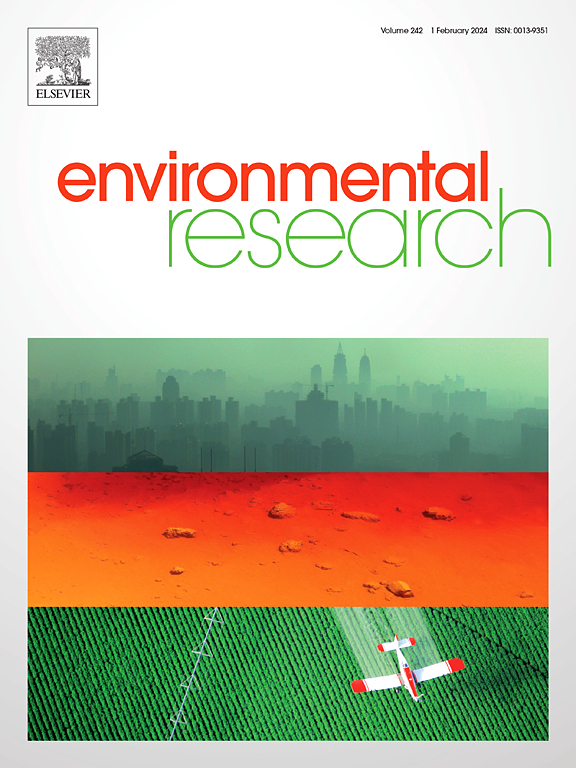野火相关烟雾和细胞外囊泡 (EV):参与细胞外基质降解和气道器官模型组织损伤的 EV 蛋白质组特征的变化。
IF 7.7
2区 环境科学与生态学
Q1 ENVIRONMENTAL SCIENCES
引用次数: 0
摘要
野火对全世界的空气质量和公众健康造成了不利影响。暴露于野火烟雾与不良健康后果有关,包括心肺疾病。围绕导致野火诱发健康影响的基本生物途径的研究仍存在重大差距。细胞外囊泡(EVs)对细胞间通信和下游毒性的调节是一种重要的、未被充分研究的生物机制。本研究调查了与野火烟雾相关的体外暴露后的 EVs。我们假设,木烟(WS)会改变有机型体外气道模型中分泌的 EVs 的蛋白质组含量。我们使用肺泡上皮细胞、成纤维细胞和内皮细胞的三培养模型以及肺泡上皮细胞和成纤维细胞的简化共培养模型进行了暴露,以了解不同细胞群的反应。上皮细胞暴露于 WS 冷凝物中,暴露 24 小时后从基底侧条件培养基中分离出 EV。接触 WS 不会影响 EV 粒子的特征,但会适度增加 EV 的数量。暴露导致从三联培养和共培养模型中收集的EVs中分别有25种和35种蛋白质不同程度地负载。参与细胞外基质降解和伤口愈合的EV蛋白在两种模型中都受到了一致的调节。然而,参与伤口愈合途径的不同蛋白质在不同模型之间发生了改变,这表明不同类型的细胞在应对损伤时进行了独特但一致的交流。这些研究结果表明,与野火相关的暴露会改变电动体蛋白质组,并对电动体介导的细胞间通讯产生影响。总之,研究结果表明了用器官型方法评估EV以研究暴露诱导的生物标志物和潜在机制的可行性。研究结果还强调了用于评估吸入毒物影响的体外模型的生物复杂性差异的影响。本文章由计算机程序翻译,如有差异,请以英文原文为准。

Wildfire-relevant woodsmoke and extracellular vesicles (EVs): Alterations in EV proteomic signatures involved in extracellular matrix degradation and tissue injury in airway organotypic models
Wildfires adversely impact air quality and public health worldwide. Exposures to wildfire smoke are linked to adverse health outcomes, including cardiopulmonary diseases. Critical research gaps remain surrounding the underlying biological pathways leading to wildfire-induced health effects. The regulation of intercellular communication and downstream toxicity driven by extracellular vesicles (EVs) is an important, understudied biological mechanism. This study investigated EVs following a wildfire smoke-relevant in vitro exposure. We hypothesized that woodsmoke (WS) would alter the proteomic content of EVs secreted in organotypic in vitro airway models. Exposures were carried out using a tri-culture model of alveolar epithelial cells, fibroblasts, and endothelial cells and a simplified co-culture model of alveolar epithelial cells and fibroblasts to inform responses across different cell populations. Epithelial cells were exposed to WS condensate and EVs were isolated from basolateral conditioned medium following 24 h exposure. WS exposure did not influence EV particle characteristics, and it moderately increased EV count. Exposure caused the differential loading of 25 and 35 proteins within EVs collected from the tri- and co-culture model, respectively. EV proteins involved in extracellular matrix degradation and wound healing were consistently modulated across both models. However, distinct proteins involved in the wound healing pathway were altered between models, suggesting unique but concerted efforts across cell types to communicate in response to injury. These findings demonstrate that a wildfire-relevant exposure alters the EV proteome and suggest an impact on EV-mediated intercellular communication. Overall, results demonstrate the viability of organotypic approaches in evaluating EVs to investigate exposure-induced biomarkers and underlying mechanisms. Findings also highlight the impact of differences in the biological complexity of in vitro models used to evaluate the effects of inhaled toxicants.
求助全文
通过发布文献求助,成功后即可免费获取论文全文。
去求助
来源期刊

Environmental Research
环境科学-公共卫生、环境卫生与职业卫生
CiteScore
12.60
自引率
8.40%
发文量
2480
审稿时长
4.7 months
期刊介绍:
The Environmental Research journal presents a broad range of interdisciplinary research, focused on addressing worldwide environmental concerns and featuring innovative findings. Our publication strives to explore relevant anthropogenic issues across various environmental sectors, showcasing practical applications in real-life settings.
 求助内容:
求助内容: 应助结果提醒方式:
应助结果提醒方式:


